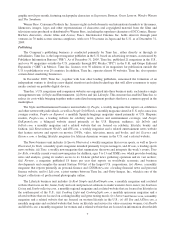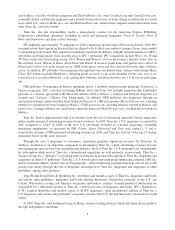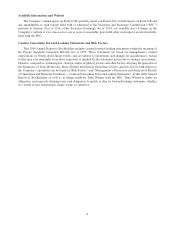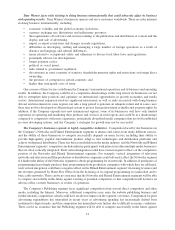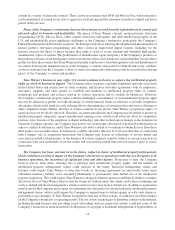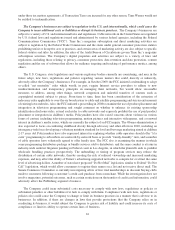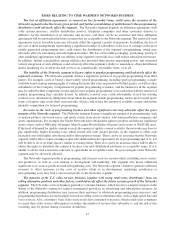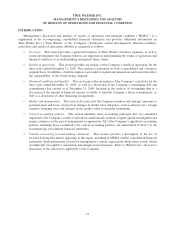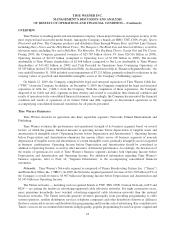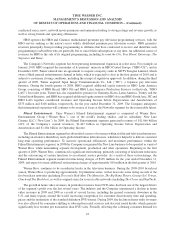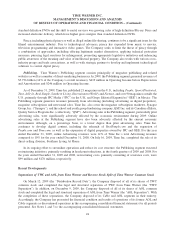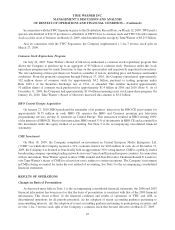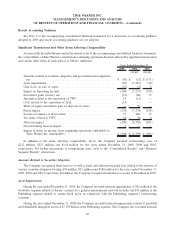Time Magazine 2009 Annual Report Download - page 29
Download and view the complete annual report
Please find page 29 of the 2009 Time Magazine annual report below. You can navigate through the pages in the report by either clicking on the pages listed below, or by using the keyword search tool below to find specific information within the annual report.RISKS RELATING TO TIME WARNER’S NETWORKS BUSINESS
The loss of affiliation agreements, or renewal on less favorable terms, could cause the revenues of the
Networks segment to decline in any given period, and further consolidation of multichannel video programming
distributors could adversely affect the segment. The Networks segment depends on affiliation agreements with
cable system operators, satellite distribution services, telephone companies and other customers (known as
affiliates) for the distribution of its networks and services, and there can be no assurance that these affiliation
agreements will be renewed in the future on terms that are acceptable to the Networks segment. The renewal of such
agreements on less favorable terms may adversely affect the segment’s results of operations. In addition, the loss of
any one of these arrangements representing a significant number of subscribers or the loss of carriage on the most
widely penetrated programming tiers could reduce the distribution of the segment’s programming, which may
adversely affect its advertising and subscription revenues. The loss of favorable packaging, positioning, pricing or
other marketing opportunities with any affiliate of the segment’s networks also could reduce subscription revenues.
In addition, further consolidation among affiliates has provided them greater negotiating power, and increased
vertical integration of such affiliates could adversely affect the segment’s ability to maintain or obtain distribution
and/or marketing for its networks and services on commercially reasonable terms, or at all.
The inability of the Networks segment to license rights to popular programming could adversely affect the
segment’s revenues. The Networks segment obtains a significant portion of its popular programming from third
parties. For example, some of Turner’s most widely viewed programming, including sports programming, is made
available based on programming rights of varying durations that it has negotiated with third parties, as well as other
subsidiaries of the Company. Competition for popular programming is intense, and the businesses in the segment
may be outbid by their competitors for the rights to new popular programming or in connection with the renewal of
popular programming they currently license. In addition, renewal costs could substantially exceed the existing
contract costs. Alternatively, third parties from which the segment obtains programming, such as professional sports
teams or leagues, may create their own networks, which could reduce the amount of available content and further
intensify competition for licensed programming.
Increases in the costs of programming licenses and other significant costs may adversely affect the gross
margins of the Networks segment. The Networks segment licenses a significant amount of its programming, such
as motion pictures, television series, and sports events, from movie studios, television production companies and
sports organizations. For example, the Turner Networks have obtained the rights to produce and telecast significant
sports events, such as NBA play-off games, Major League Baseball play-off games and a series of NASCAR races.
If the level of demand for quality content exceeds the amount of quality content available, the networks may have to
pay significantly higher licensing costs, which in turn will exert greater pressure on the segment to offset such
increased costs with higher advertising and/or subscription revenues. There can be no assurance that the Networks
segment will be able to renew existing or enter into additional license agreements for its programming and, if so, if it
will be able to do so on terms that are similar to existing terms. There also can be no assurance that it will be able to
obtain the rights to distribute the content it licenses over new distribution platforms on acceptable terms. If it is
unable to obtain such extensions, renewals or agreements on acceptable terms, the gross margins of the Networks
segment may be adversely affected.
The Networks segment produces programming, and it incurs costs for creative talent, including actors, writers
and producers, as well as costs relating to development and marketing. The segment also incurs additional
significant costs, such as production and newsgathering costs. The Networks segment’s failure to generate sufficient
revenues to offset increases in the costs of creative talent or in development, marketing, production or
newsgathering costs may lead to decreased profits at the Networks segment.
The maturity of the U.S. video services business, together with rising retail rates, distributors’ focus on
selling alternative products and other factors, could adversely affect the future revenue growth of the Networks
segment. The U.S. video services business generally is a mature business, which may have a negative impact on the
ability of the Networks segment to achieve incremental growth in its advertising and subscription revenues. In
addition, programming distributors may increase their resistance to wholesale programming price increases, and
programming distributors are increasingly focused on selling services other than video, such as high-speed data and
voice services. Also, consumers’ basic video service rates have continued to increase, which could cause consumers
to cancel their video service subscriptions or reduce the number of services they subscribe to, and the risk of this
occurring may be greater during economic slowdowns.
17


